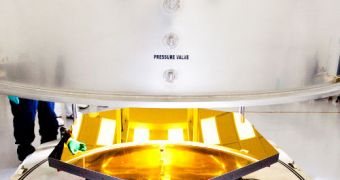The effort to construct the massive James Webb Space Telescope (JWST) has reached a critical mission milestone on April 6. Engineers managed to complete the construction of a giant structural steel frame, that will act as a stand for the components of the flight optics system.
What the huge assembly will do is it will provide essential support for the mirrors that will make up the telescope's “eyes.” JWST will conduct its observations with the help of 18 hexagonal mirror segments, which can be individually adjusted and deformed to provide perfect focus.
The steel frame was completed by experts with the ITT Corporation, one of the subcontractors selected by the primary constructor of the new telescope, the Northrop Grumman corporation. The latter is managing both the design and development of the James Webb.
The company was selected as the main contractor by the NASA Goddard Space Flight Center (GSFC), in Greenbelt, Maryland, which will manage the new instrument. The JWST is designed to replace the famous Hubble Space Telescope, which has spent more than 21 years in orbit.
According to officials at Northrop, the finalization of the optics system stand marks the completion of all major design elements required for the telescope. Over the last year, ITT has already constructed and tested the mirrors that will fly to space soon.
“We now have the platform to assemble the flight hardware and a precision robotic arm, thanks to the excellent work of our partner, ITT,” announces Scott Willoughby.
“Completing the assembly stand is a significant step forward in the observatory's integration and test phase,” adds the official, who is the Northrop Grumman Aerospace Systems JWST director.
“ITT has provided precision systems that help the scientific world view and gather images and data from space for more than 50 years,” adds ITT Geospatial Systems (ITT-GS) Intelligence, Surveillance and Reconnaissance systems VP and general manager, Rob Mitrevski.
“We are proud of this important achievement and our role with the Webb telescope, which will provide unprecedented images of the universe's first stars and galaxies,” he goes on to say.
The recently-finished assembly has the shape of the letter “U” and weights in excess of 139,000 pounds (63,050 kilograms). It is the basis of the entire telescope, which means that it needs to be able to support a load of 3.7 metric tons.
When completed, the JWST will be the most advanced orbital telescope ever constructed, exceeding the European Space Agency's (ESA) Herschel Observatory in complexity and capabilities.

 14 DAY TRIAL //
14 DAY TRIAL //